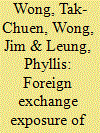| Srl | Item |
| 1 |
ID:
089552


|
|
|
|
|
| Publication |
2009.
|
| Summary/Abstract |
Using the capital market approach and the equity price data of 14 listed Chinese banks, this empirical study finds that there is a positive relationship between bank size and foreign exchange exposure. This relationship may reflect the larger foreign exchange operations and trading positions of larger Chinese banks and their significant indirect foreign exchange exposure arising from impacts of the renminbi exchange rate movements on their customers. Empirical evidence also suggests that the average foreign exchange exposures of state-owned and joint-stock commercial banks in China are higher than those of banks in Hong Kong, notwithstanding their limited participation in international banking businesses compared with their Hong Kong counterparts. It is also found that negative foreign exchange exposure is prevalent for larger Chinese banks, suggesting that an appreciation of the renminbi tends to reduce their equity value. It is therefore likely that the banking sector's performance will be hampered. Together with the fact that decreases in equity values generally imply a higher default risk, the effects of different scenarios of renminbi appreciation on the default risk of Chinese banks should therefore be closely monitored.
|
|
|
|
|
|
|
|
|
|
|
|
|
|
|
|
| 2 |
ID:
150712


|
|
|
|
|
| Summary/Abstract |
In India, a significant barrier to market-competitiveness of renewable energy is a shortage of attractive debt. Domestic debt has high cost, short tenors, and variable interest rates, adding 30% to the cost of renewable energy compared to renewable energy projects elsewhere. Foreign debt is as expensive as domestic debt because it requires costly market-based currency hedging solutions. We investigate a government-sponsored foreign exchange facility as an alternative to reducing hedging costs. Using the geometric Brownian motion (GBM)2 as a representative stochastic model of the INR–USD foreign exchange rate, we find that the expected cost of providing a currency hedge via this facility is 3.5 percentage points, 50% lower than market. This leads to an up to 9% reduction in the per unit cost of renewable energy. However, this requires the government to manage the risks related to unexpected currency movements appropriately. One option to manage these risks is via a capital buffer; for the facility to obtain India's sovereign rating, the capital buffer would need to be almost 30% of the underlying loan. Our findings have significant policy implications given that the Indian government can use this facility to make renewable energy more competitive and, therefore, hasten its deployment.
|
|
|
|
|
|
|
|
|
|
|
|
|
|
|
|